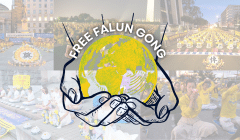U.S. Wigs Made by Falun Gong Practitioners Turned Slaves
Import-Export Henan Style: implementing new torture techniques while manufacturing hair products

Falun Gong practitioners are purchased for 800 RMB each and utilized as slave labor to produce products for Henan Rebecca Inc.
TORONTO (FDI) – Hair product giant Henan Rebecca Inc. is in cahoots with notorious Chinese labor camps that are buying Falun Gong practitioners as slave labor, sources in China say. Labor camps such as Shibalihe and Xuchang buy these people for 800 RMB each (almost $100 US), force them to work day and night, and torture them to death as part of the “reeducation” program.
The labor camps are located in Henan Province, where hair products are the province’s number-one export. Henan Rebecca describes itself as “the largest hair product company in China and one of the biggest in the world,” including the U.S. Its products are sold worldwide under many brand names, including Shake-N-Go Hair and Royal Imex, Inc.
“Many of these wig product factories don’t hire a lot of employees outright,” says a source in China who is familiar with forced labor contracts. “Instead, they rely heavily on the slave labor of detainees in forced labor camps, jails and detention centers, including many illegally detained Falun Gong practitioners.”
One of these camps, the No. 2 Shibalihe Female Labor Camp located in Henan’s Zhenzhou City, was assigned a new director in May 2003. After arriving at the position Qu Shuangcai — previously the head of the No. 3 Xuchang City Labor Camp — quickly imported the torture methods from his former labor camp in an effort to force Falun Gong practitioners to renounce their belief system. Within several months at least three practitioners died of this torture, including Ms. Zhang Yali, an accountant in her thirties.
Sources say Qu also signed a production contract with Henan Rebecca and began manufacturing hair products for export. Qu’s former labor camp also manufactures hair products for the same purpose.
“A while back, when the labor camp was short of funding and was about to be shut down, many Falun Gong practitioners became available,” said Shen Jianwei, a guard at the Xuchang camp. “The government allocated 20,000 Yuan to ‘reform’ each practitioner. The labor camp used eight million Yuan of this government funding to construct residential buildings to encourage the guards to persecute these practitioners.”
Currently, the labor camp is buying Falun Gong practitioners from other places as slaves to increase production volume. Sources familiar with the Xuchang camp state that prisoners are forced to work overtime, day and night, under high-pressure supervision. If prisoners make a slight mistake, they are beaten by the guards.
Falun Gong practitioners at the camp have received a heightened workload and those who are not able to complete the work on time are deprived of sleep, forced to stand against the wall and have had their sentences extended. Two young Falun Gong practitioners, Mr. Li Jian and Mr. Yao Sanzhong were tortured to death at the Xuchang camp.
The Xuchang labor camp was awarded the “National Civilized Work Unit” citation from the Central Politics and Law Committee’s “6-10 Office” (about) and the Labor Camp Bureau. The award applauded the treatment of Falun Gong practitioners at the camp.
Included among the methods used to torture practitioners in these Henan camps is a technique in which guards tie practitioners’ arms behind their backs in a straight jacket. According to an eyewitness account, the arms are then raised over the shoulders to the chest and the victims suffer broken arms, torn tendons, as well as dislocated shoulders, wrists, and elbows. The practitioners’ legs are tied and they are hung upside down from the windows; the guards gag practitioners’ mouths with cloth and place earphones to drill anti-Falun Gong propaganda into their minds. The spines of those who endure this torture for a long time are sometimes broken, killing the individual.
On May 22, 2003, a female Falun Gong practitioner in her 40’s was tortured this way for 24 hours at Shibalihe. When she was extricated from the strait jacket the next day, her body was already cold. To cover up the murder, guards ordered inmates to take her body to the hospital for an injection. They later claimed she died of a sudden illness.








